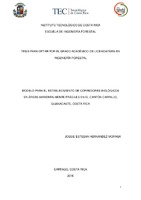Modelo para el establecimiento de corredores biológicos en áreas ambientalmente frágiles en el cantón Carrillo, Guanacaste, Costa Rica
Resumen
Fragmentation processes, modify natural ecosystems due to many human activities, such as forest foliage removal, development of infrastructure, extensive ranching and more. To maintain the dynamics of such ecosystems, it is extremely indispensable to take into account the landscape connectivity, which contributes with the growth of biodiversity and diminishes the isolated fragments of forest. For this reason, it turns crucial to incentivize on the biological corridors that allow reestablishing and preserving that connectivity, as they contribute with the wild fauna’s population persistence and reinforce the key areas for the preservation of the ecosystems. In this investigation, a model for the restoration of biological corridors through connectivity inside of the town of Carrillo, Guanacaste, Costa Rica is proposed. With the purpose of determining the fragmentation and connectivity of the town, the map of Types of Forests of Costa Rica 2012 was validated with field data, proving its reliability with a 93% of accuracy, for the forest and non-forest categories. In addition, it was determined that the town is highly fragmented; with a 5% level of fragmentation. The howler monkeys (Alouatta palliata) were selected as the connecting indicator species for their tolerance towards the loss and destruction of the habitat, their diet’s elasticity and their persistence in small forests fragments. The connectivity to create the resistance layer in the town was analyzed with five physical-environmental variables, and two possible short-distance routes were created to guarantee that such routes would be completely functional, and that they would facilitate the connectivity and mobility of the howler monkey. Finally, it was established that the width of 100 meters from the selected routes, is the best to restore the fragile areas through reforestation and in this way, increase the biodiversity of the town as an environmental and touristic attraction.
Descripción
Proyecto de Graduación (Licenciatura en Ingeniería Forestal) Instituto Tecnológico de Costa Rica, Escuela de Ingeniería Forestal, 2015.


